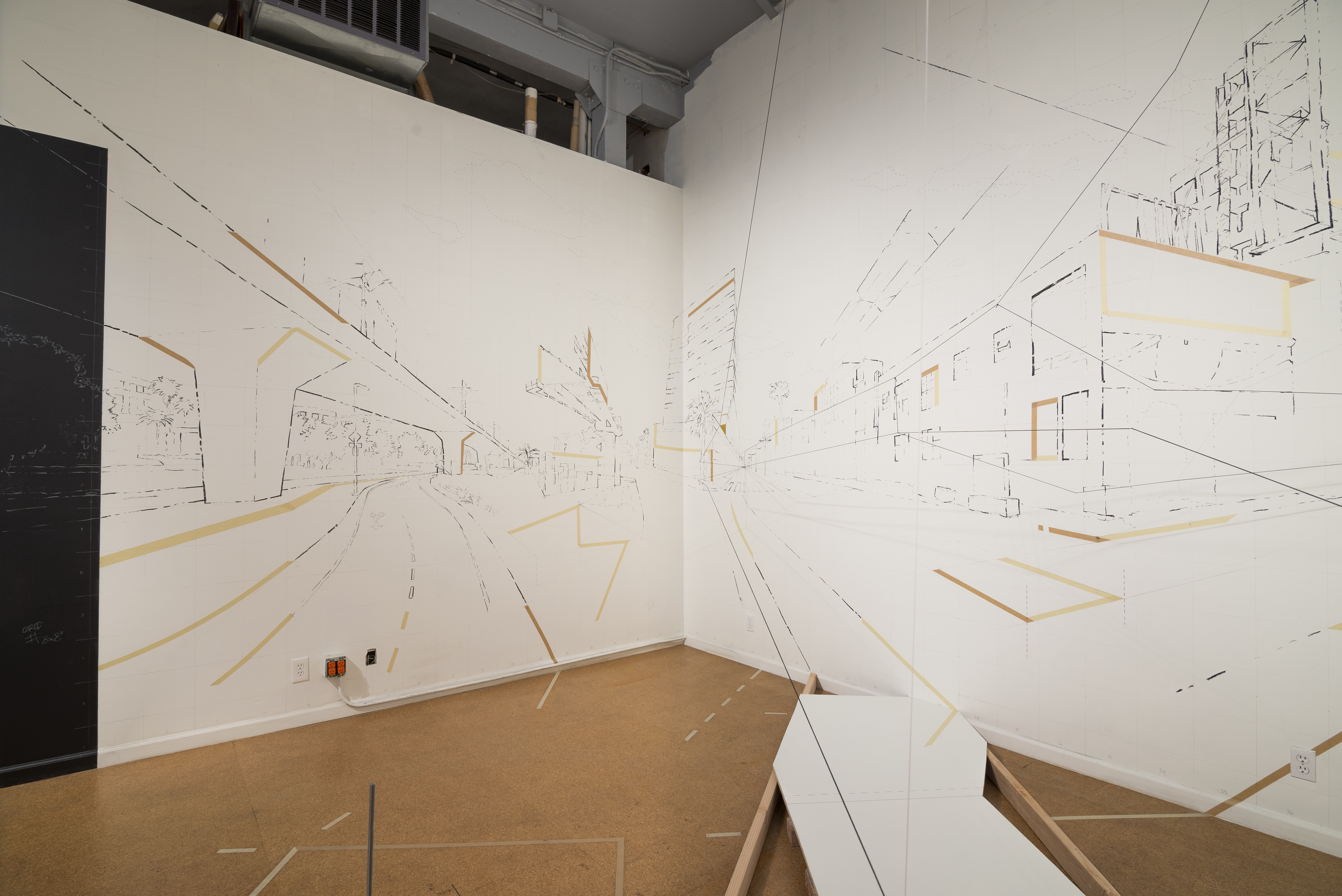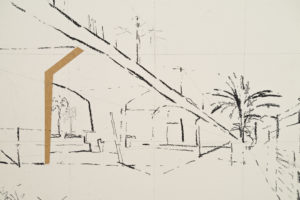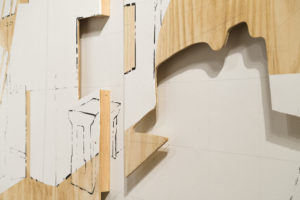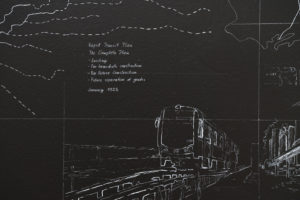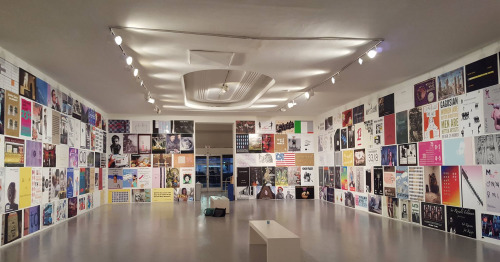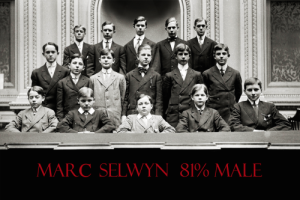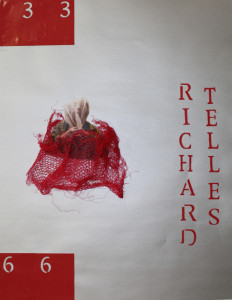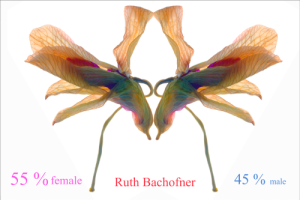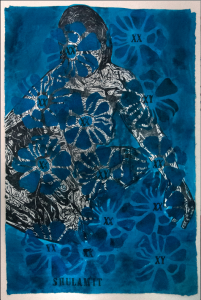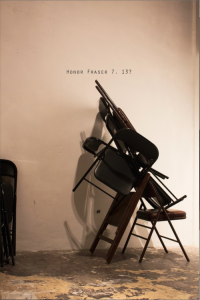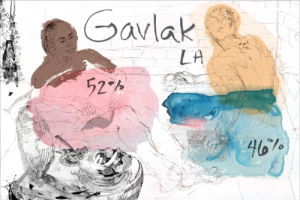Your cart is currently empty!
Tag: Los Angeles Contemporary Exhibitions
-

Los Angeles Contemporary Exhibitions:
Miha Strukelj
A tram cable traverses The Project Room, a tiny cube tucked behind the main gallery space of Los Angeles Contemporary Exhibitions. LACE, on Hollywood Boulevard, is the perfect location for educating the public about Los Angeles contemporary art. Sheltered from the hubbub of the boulevard, The Project Room is a haven for imaginary universes such as Miha Strukelj’s installation, Here Somewhere. Open through August 14, Strukelj’s work mediates between memory and imagination in constructing a hypothetical, alternative urban landscape of Los Angeles—specifically an LA with a cohesive transit system.

Miha Strukelj: Here Somewhere (2016),
Installation detail, Los Angeles Contemporary Exhibitions.
Photo: Chris WormaldCharcoal drawings of classic Los Angeles imagery inhabit most of the space, a wilderness of office buildings planted next to towering palm trees with an uncharacteristically quiet freeway overpass snaking through the cityscape. Though all familiar traits of the region, these Angeleno motifs are not anchored to any specific landmark, coaxing the viewer to mentally complete this imaginary narrative with their own idea as to where this generic slice of LA could exist. Strukelj uses not only calculated visual perspective, but also three dimensional ripples in the space, such as the cable stretching across a corner and an abstracted plywood continuation of the street drawn on the wall, carefully arranged on the floor yet seemingly unfinished, like an idea that has not quite been fully realized.

Miha Strukelj: Here Somewhere (2016),
Installation detail, Los Angeles Contemporary Exhibitions.
Photo: Chris WormaldWhile the north and east walls present the viewer with a fictitious Los Angeles in the style of architectural plans, the south wall disintegrates into the skeleton of a road map, transforming from delicate charcoal lines into scuffed, yellow masking tape, a more ephemeral medium, easily removed and re-situated according to re-imaginings.

Miha Strukelj: Here Somewhere (2016),
Installation detail, Los Angeles Contemporary Exhibitions.
Photo: Chris WormaldThe installation omits extraneous details, particularly citizens or cars, which leads the viewer to focus on place, but also leaves a pregnant silence. This is where the west wall comes into play, with illustrations of public transport, diagrams of potential constructions, and a list of regions and neighborhoods in Los Angeles. Strukelj presents a generic Los Angeles cityscape and a suggestion of a coherent metro system, challenging the viewer to use their imagination in combining them.
Miha Strukelj: Here Somewhere, June 29 – August 14, 2016 at Los Angeles Contemporary Exhibitions, 6522 Hollywood Blvd., Los Angeles, CA 90028, welcometolace.org/
-

Artists’ Parity at LACE
In 1985, an anonymous group of women artists interested in exposing gender inequality in the art world formed the Guerrilla Girls, a collective whose members wore guerrilla masks to art events, gave lectures and created posters, ads and stickers to publicize their cause. With similar objectives to bring attention to a problem that hasn’t changed much in almost 30 years, The Gallery Tally Poster Project was started in 2013 by Los Angeles based multi-disciplinary artist Micol Hebron. Presented in various incarnations at local and national venues since its inception,(en)Gendered (In)Equality: The Gallery Tally Poster Project is on view at Los Angeles Contemporary Exhibitions (LACE). This is the second time the project has been shown in its entirety.

Serena Potter, Gallery Tally Poster Project, courtesy of Serena Potter and Micol Hebron. The Gallery Tally Poster Project is a collective/communal project in which anyone can participate. Artists are invited to make a poster of a specific size (24 x 36 inches) for any gallery world-wide, based on statistics found on the gallery’s website that state the number of male versus female artists represented. The design, color, typography and directness or subtlety of the message lies in each artist’s hands.

Karen Schifman, Gallery Tally Poster Project, courtesy of Karen Schifman and Micol Hebron. More than 400 posters at LACE track the relationship of represented male and female artists around the world. The project started with Los Angeles venues but soon blossomed into a global tally. Since 2011, Micol Hebron has been conducting research on gender statistics in the art world, and in 2013 she posted a chart that tallied 50 Los Angeles based galleries. After much positive response through social media and in the press, Hebron decided to invite others to continue the research and join the project which resulted in the first showing of 75 posters at West LA College Gallery.

Janice Tieken, Gallery Tally Poster Project, courtesy of Janice Tieken and Micol Hebron. Though not anonymous, some of the posters on view at LACE are not signed or attributed directly to their creator (while others are). A list can be found at the reception desk that maps artist to poster, but attribution is hardly the point. What makes the exhibition so wonderful is the range of styles and ways of interpreting the data.

Cathy Weiss, Gallery Tally Poster Project, courtesy of Cathy Weiss and Micol Hebron. Core to the project is giving a voice to the under-represented and empowering change through the public display of facts. As Hebron states, “We have engaged in a positive, creative response to this very negative data. The data has provided an opportunity to build a new community of concerned and engaged citizens in the art world, and to showcase each individual artist’s creative voice within the group collaboration. It is a response and alternative to the hegemonic, hierarchical, patriarchal, hetero-normative ‘standard’ that has unjustly dominated the art world for far too long.”

Patricia Burns, Gallery Tally Poster Project, courtesy of Patricia Burns and Micol Hebron. Upon entering the exhibition space, viewers are confronted with a floor to ceiling, wall to wall grid of posters—arranged roughly from worst to best—visualizing the bias and imbalance in gallery representation within the art world. Viewers can look for galleries they know and reflect on the male/female ratios with surprise (or not) at the gender imbalance. Some posters parody Artforum ads like the prominent back-cover that has been taken out for years by the Swiss Galerie Bruno Bischofberger (100% male). Others matter-of-factly represent the artist list from the gallery website, as in the poster for ACE gallery where female artists’ names are in pink blocks and male artists names in blue, making for an easy comparison. Male artists in many of the posters are represented by bananas whereas female artists are other less phallic types of fruit. Some posters are represented with happy (or sad) faces—Rosamund Felsen is written out as a smile with the number 48% as the nose and the numbers 31 (total artists) and 15 (women) becoming eyes. Some are visual representations (CB1 at 50/50 is depicted as a proud peacock whose spots are the classic gender symbols: blue/male and red/female. While other posters are pure type: 13% women, Fahey Klein Gallery.

Kate Sikorski, Gallery Tally Poster Project, courtesy of Kate Sikorski and Micol Hebron. Some designs are clearly more aesthetically pleasing or more humorous than others, but more importantly, this project expresses the power of numbers and of the collective voice by taking charge and visualizing data that might otherwise be ignored or suppressed and by bringing to light inequalities that have existed for a long time with the goal of inciting change.
(en)Gendered (In)Equality: The Gallery Tally Poster Project, Organized by Micol Hebron, March 10 – April 17, 2016 at Los Angeles Contemporary Exhibitions (LACE), 6522 Hollywood Boulevard, Los Angeles, CA 90028, www.welcometolace.org.
